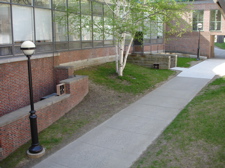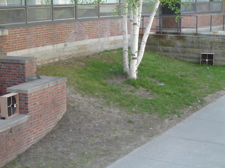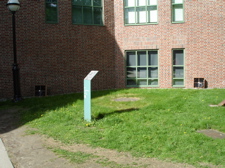I think I know you (you think I don't) (2007)
a discoverable music installation with 8-channel audio and parabolic loudspeaker reinforcement
IMAGES












May 2007, Dartmouth College, Hood Museum of Art
LISTEN .mp3
pre-composition, duration: 10'29"
CONCEPT
For a composition to be discoverable interactivity is not a necessary condition for constructing a flexible and cohesive integration of sound, behavior, and environment. A discoverable composition must only situate sound in a particular space while not explicitly presenting the resulting context as musical. In this way, discoverable composition is a particular approach to soundscape composition. In trying to explore ideas relating to soundscape composition through a discoverable dynamic, I became interested in the idea of composing a soundscape by situating recordings in a sonically rich and dynamic context. The manipulated sound material of the composition is contextualized through its performative setting, as the richness of its sonic environment is framed and embraced as an integral component of the music.
Instead of using field recordings of environmental sounds, or even recordings of the environment where the composition was ultimately situated, the source material was derived from samples taken from sound effects libraries. These pre-fabricated sound objects are composed and catalogued as being representative of a range of nuanced real-world sounds. Issues relating to the perceived authenticity/inauthenticity of disembodied sound become important when sound effect library samples are used as the source material for a composed soundscape. Situating the composition in a natural and dynamic setting further complicates the musical experience, heightening the tension between authentic and inauthentic sound. These sound samples are far removed from their original sources. By placing them in a discoverable context, the sounds could possibly be misconstrued as occurring within the environment, breathing new life into these acousmatic samples.
The artistic goal of this composition is to integrate these 'foreign' sounds into the natural soundscape occurring within the performance space. The resulting music is both the sound coming from the speakers and from the environment. People, who pass through the composition and become aware of it, hopefully experience a heightened sensitivity to the soundscape as a whole, if only because they are trying to differentiate the authenticity of sounds.
IMPLEMENTATION
Sound samples were chosen from the BBC Sound Effects Library based on their ability to fall within four predefined taxonomies: environments, animals, industrial/building, and people. Using these samples as the source material, a composition was made, that focused on layering and juxtaposing sounds from each of the groupings in sonically rich ways. The separation between sound taxonomies was not maintained during this compositional process. The resulting composition was then re-divided into the four groups of sounds, resulting in four stereo compositions. The stereo tracks were then split, yielding eight mono tracks.
The installation is designed to be installed a courtyard (or two adjacent courtyards). Four parabolic speakers are placed in various locations around the site, without being overtly conspicuous. Using a Max/MSP patch, the 8 audio tracks are continuously re-distributed among eight speakers by randomly selecting from a predefined list of channel configurations.
DIAGRAM
